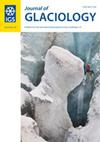Development of a drone-based ground-penetrating radar system for efficient and safe 3D and 4D surveying of alpine glaciers
IF 2.6
3区 地球科学
Q2 GEOGRAPHY, PHYSICAL
引用次数: 0
Abstract
Recent research has highlighted the potential for high-resolution, high-density, 3D and 4D ground-penetrating radar (GPR) acquisitions on alpine glaciers. When carried out on foot, such surveys are laborious and time consuming, which limits their application to small domains of limited glaciological interest. Further, crevasses and other hazards make the data acquisition risky. To address these issues, we have developed a drone-based GPR system. The system has a payload weight of 2.2 kg and a data output rate of 14 traces per second. An 80-MHz antenna and a recording time of 2800 ns mean that depths of over 100 m can be reached in temperate ice. Differential GPS positioning assures accurate flight paths. At a speed of 4 m s基于无人机的高寒冰川三维和四维高效安全探地雷达系统的研制
最近的研究强调了在高山冰川上进行高分辨率、高密度、3D和4D探地雷达(GPR)采集的潜力。当徒步进行时,这种调查既费力又耗时,这限制了它们在冰川学兴趣有限的小范围内的应用。此外,裂缝和其他危险使数据采集具有风险。为了解决这些问题,我们开发了一种基于无人机的探地雷达系统。该系统的有效载荷重量为2.2 kg,数据输出速率为每秒14道。80mhz的天线和2800 ns的记录时间意味着在温带冰层中可以达到超过100米的深度。差分GPS定位确保精确的飞行路径。在4米每秒1的速度和冰川表面以上5米的高度,我们的系统可以在20分钟内获得超过4线公里的GPR数据,单套无人机电池。在介绍了系统的技术规格和优化其性能所需的测试之后,我们展示了最近从瑞士Otemma冰川获取的3D数据集,其中仅在4天内就以1米的线间距调查了462条平行GPR剖面,总计超过112线公里的数据。
本文章由计算机程序翻译,如有差异,请以英文原文为准。
求助全文
约1分钟内获得全文
求助全文
来源期刊

Journal of Glaciology
地学-地球科学综合
CiteScore
5.80
自引率
14.70%
发文量
101
审稿时长
6 months
期刊介绍:
Journal of Glaciology publishes original scientific articles and letters in any aspect of glaciology- the study of ice. Studies of natural, artificial, and extraterrestrial ice and snow, as well as interactions between ice, snow and the atmospheric, oceanic and subglacial environment are all eligible. They may be based on field work, remote sensing, laboratory investigations, theoretical analysis or numerical modelling, or may report on newly developed glaciological instruments. Subjects covered recently in the Journal have included palaeoclimatology and the chemistry of the atmosphere as revealed in ice cores; theoretical and applied physics and chemistry of ice; the dynamics of glaciers and ice sheets, and changes in their extent and mass under climatic forcing; glacier energy balances at all scales; glacial landforms, and glaciers as geomorphic agents; snow science in all its aspects; ice as a host for surface and subglacial ecosystems; sea ice, icebergs and lake ice; and avalanche dynamics and other glacial hazards to human activity. Studies of permafrost and of ice in the Earth’s atmosphere are also within the domain of the Journal, as are interdisciplinary applications to engineering, biological, and social sciences, and studies in the history of glaciology.
 求助内容:
求助内容: 应助结果提醒方式:
应助结果提醒方式:


